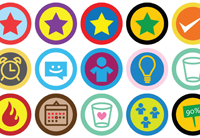
Process Corner
Gamification in the Workplace

You have to learn the rules of the game. And then you have to play better than anyone else." - Albert Einstein
At a recent national ITSM conference, I attended a session called "Motivation through Gamification." Gamification is the use of game design techniques, game thinking and game mechanics to enhance non-game contexts.
Gamification is a trending area that is being talked about a lot in ITSM, specifically for service desks and other operational groups. It can even be used to promote activities such as creating new knowledge articles. The idea is to find ways to engage employees and get additional enthusiasm behind the work they are doing.
Gamification is also a fairly new concept. Omnicare is one company has implemented it with great results, where help desk agents can earn badges and rewards based on completing certain activities, much the way games such as Angry Birds, Foursquare, and Farmville encourage players to continually reach new levels of achievement (listen to a presentation about the Omnicare implementation). What is created is an engaging work environment with built-in feedback and incentives.
Gamification can also be used for collaboration. Recent studies have found that even better results can realized when teams collaborate for achievements. By contributing pieces of a puzzle that cooperate towards the realization of one goal, gamification can work well at bringing a team together to achieve desired outcomes.
2011 was a big year for gamification, with increasing international investment across the industry. ITSM tools are starting to integrate gamification features into their products. Within five years the majority of ITSM tools will have gamification features built in. It is happening everywhere. Outside of IT, gamification is being used in educational tools, training guides, health programs, and many more areas than you probably realize.
When I presented the concept of gamification in a recent team meeting at Emory, I was struck by the varied reactions from my colleagues. I turned to the twitterverse for support. Chris Dancy, a leading Social Media and ITSM expert, responded by implying that people are slow to awaken to new ideas.
Obviously, it will take time to convince the skeptics. But let’s not forget that there is a whole generation entering the workforce who have been raised on game-like features and social media. Let’s keep in mind the Emory students, and the schools that must constantly find new ways to engage them using the tools and methods that are most familiar to a young audience, such as gamification and social media.
It has become a significant challenge to stay abreast of the social media world, but it simply is not going away. As IT workers, we should be on the cutting edge here. But if we look around, it’s unfortunate to find that often we are the ones who need to catch up. For example, a quick browse through the various Emory news sites will reveal that the OIT Newsletter you are reading right now is one of the only Emory news sites still missing basic social media integration.
The question now is, will Emory adopt an overall social media strategy, and who will lead it? Will we in central IT take that challenge and step forward to provide guidance to the schools and divisions as we move forward into a new era of technology? Can we partner with them to offer new and exciting solutions utilizing tools like gamification? The need is there. The conversations are already happening. And we should have a place at the table.
For more information about Omnicare gamification, go to: http://community.service-now.com/blog/deena-troy/Michael-Slabodnick-Omnicare-gamification-people-people.
- Mark Kawasaki, IT SM Specialist, Integration
No more "FYIs" for change

The SMCC Team is constantly working to improve its processes.
The Major Incident Management Process has recently changed. As part of that update, we have created a new process for managing change notices. This is an improvement from an Incident Management and Change Management perspective as the previous process created confusion when receiving emails and distinguishing an FYI (Change-related) from a MIN (Incident-related).
As a result there have been guidelines developed for the communication around Change Management and the necessary documentation has been updated.
Three notable modifications are (please see updated documentation for all modifications, "Specification & Guidelines"): 1.) Introduction of a new LISTSERV address: MAINTENANCE-NOTICE@LISTSERV.CC.EMORY.EDU, 2.) Renaming from "FYI" to “Maintenance Notice", and 3.) Utilizing the template provided to generate the Maintenance Notice ("Maintenance Notice Template").
The new guidelines have been in effect as of February 1, 2012. If you have any questions, please contact me at 404-727-1120 or by email at ldallav@emory.edu.
- Luciano Dalla Venezia, IT Service Manager, Integration